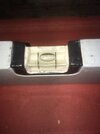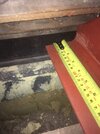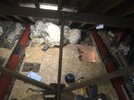- Joined
- 29 Sep 2024
- Messages
- 6
- Reaction score
- 2
- Country

We are in the process of having the chimney removed. So the builders have just put in two RSJs (152x152x23-5350mm). They sit on engineering bricks and steel plates at both ends. One end was chamfered to fit the roofline. The RSJs sit on 10mm steel plates at the roof side and 15mm plates at the chimney end.
Structural engineers report said:-
For purposes of beam bearings conservatively 5N/mm2 bricks in 1:2:9 mortar has been assumed (0.42N/mm2 allowable bearing stress - unfactored) although Fletton brickwork is in place. At the flank wall to avoid the beam protruding through the roof the end will be chamfered.
Bearing R1: 10 mm m.s. bearing plate, size 175 x 100 mm
Now all looks ok bar two small things.
- One there is only 80mm of RSJ on the bearing at the roof side. Note the builder will be moving the plate on Monday so it covers the full brick but that will only be 80mm.
- Two both of the RSJs are not quite level maybe out by 2mm per meter at a guess so maybe 10-12mm over the 5.3 meter length.
See photos.
Are these acceptable tolerances? Building control is coming on Tuesday.
Structural engineers report said:-
For purposes of beam bearings conservatively 5N/mm2 bricks in 1:2:9 mortar has been assumed (0.42N/mm2 allowable bearing stress - unfactored) although Fletton brickwork is in place. At the flank wall to avoid the beam protruding through the roof the end will be chamfered.
Bearing R1: 10 mm m.s. bearing plate, size 175 x 100 mm
Now all looks ok bar two small things.
- One there is only 80mm of RSJ on the bearing at the roof side. Note the builder will be moving the plate on Monday so it covers the full brick but that will only be 80mm.
- Two both of the RSJs are not quite level maybe out by 2mm per meter at a guess so maybe 10-12mm over the 5.3 meter length.
See photos.
Are these acceptable tolerances? Building control is coming on Tuesday.



